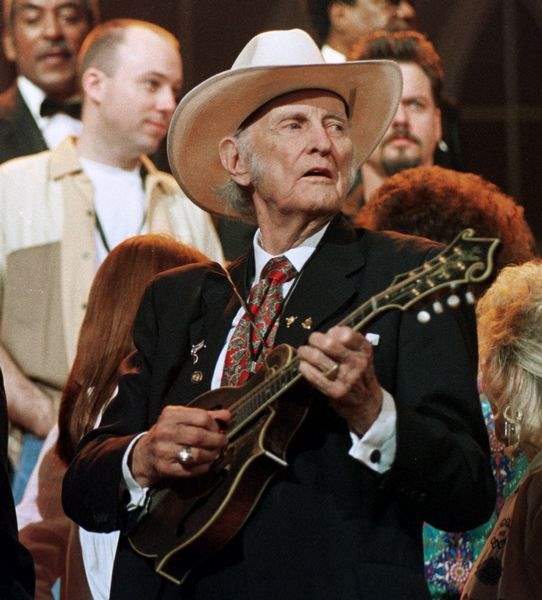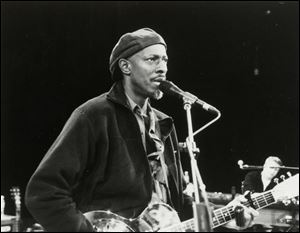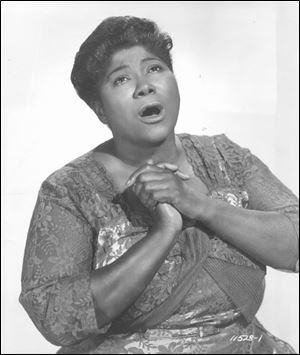
PBS series eamines relationship betwen American music forms
10/28/2001
Bill Monroe
AP
At first glance, it seems like someone strumming a bad chord: Howlin' Wolf, Mahalia Jackson, Woody Guthrie, Earl Scruggs, Flaco Jimenez, and R. Carlos Nakai on the same program?
It's a clash of musical styles, no doubt. Wolf plays guttural blues; Jackson sings angelic gospel; Guthrie uses folk songs for social commentary; Scruggs plucks the bluegrass banjo with blinding speed; Jimenez is the accordion king of Tejano music; Nakai creates ethereal magic with the Native American flute.
But their differences reflect the nation's cultural diversity, and their styles blend together in perfect harmony on American Roots Music, a four-part PBS series that begins tomorrow.
“There was a conscious effort to find a common denominator in all the music, and really what that was a reflection of the American character,” said Bob Santelli, a series contributor and CEO of the Experience Music Project in Seattle. “The beauty of the American character is its diversity and regionalism.”

Keb' Mo' says the series may help people see where different musical styles fit in.
The documentary series, to be broadcast in one-hour segments each of the next four Monday nights, takes a broad look at a vast array of artists and styles that led to the music we hear today.
“Without roots music, there would be no American music or modern popular culture today,” singer Bonnie Raitt writes in a foreword to the series' companion book. “No jazz, no rhythm and blues, no pop music, no rock and roll, no Beatles, no Rolling Stones, no MTV, no rap.”
The series is narrated by Kris Kristofferson and consists of a fast-paced mix of interviews, performance shots, and archival footage. Among those interviewed are Keith Richards, Robbie Robertson, Arlo Guthrie, Ricky Skaggs, Rufus Thomas, Doc Watson, Marty Stuart, and Gillian Welch.
Producer Jim Brown, a three-time Emmy Award winner known for such programs as The Weavers: Wasn't that a Time! And In the Hank Williams Tradition, said he was afraid that much of this music would be lost if someone didn't make an effort to preserve it.

Bill Monroe
“I had been talking with Bill Ivey about doing a folk series way before he became chairman of the National Endowment for the Arts,” Brown said in an interview from his home in suburban New York City. “When he got into office, I mentioned that this would be a great time, at the end of the 20th century, to recognize and celebrate this unique American music.”
In 1998, Brown received a “chairman's grant” from the NEA and formed a panel of scholars who spent two years organizing the series. He also received support from the Library of Congress, the Smithsonian Institution, the Rock and Roll Hall of Fame, the Country Music Hall of Fame, and a total of 175 musical repositories.
“Our goal was not to be encyclope
dic,” Brown said, “but to present a tapestry of American music in a documentary that showed the key people and the key periods. Of course, a lot of people got left out.”
Brown's friend, Jeff Rosen, who is Bob Dylan's manager, provided much of the rare footage. Rosen and Dylan have been collecting private videos and archival footage of American roots music for 35 years and enjoy watching the films while crossing the country on their tour bus.
“One of the keys to the success of American Roots Music is the amount of never-before-seen footage that Jim Brown and his team found,” Santelli said. “He brought Rosen into the project early on and was able to bring us a lot of the rare films, like the early Cajun stuff and the folk revival scenes of the early 1960s.”

Mahalia Jackson
Historic footage from ethnomusicologist John Lomax and his son, Alan, also contribute highlights with their field recordings of the first half of the 20th century. The Lomaxes were among the first to recognize the uniqueness and validity of cowboy music, spirituals, field hollers, and blues.
One important element of American Roots Music is its recognition of Native American music, a genre that has not only been overlooked by many books and documentaries, but which also faced the threat of extinction.
“Americans decimated Native American music,” Brown said. “Parents washed their kids' mouths out with soap if they sang it. The elders in the tribes realized that something would be lost, so they taught their kids the songs they felt were important to them.”
Santelli said the organizers agreed that Native American music was an essential part of the series.
“If we were going to make this an ‘American roots music' project, the music of Native Americans needed to be included. It had been pushed aside, relegated to the other side of the radar screen,” Santelli said.
The series shows how the advent of new technologies had an impact on the music. The arrival of railroads, highways, and airplanes allowed people to travel across the country, sharing the music of their home region.
The invention of the Victrola gave people a chance to hear music, via recordings, that previously could only be heard live. Radio proved to be a powerful influence on the nation's cultural landscape, sending music across geographical and ethnic boundaries. During the Great Depression, when people couldn't afford to buy records, they could tune in to the radio and listen for free.
Keb' Mo', a singer-songwriter whose retro style has a strong link to roots music, said the series should help people understand the ingredients that blend together to form modern music.
“If you're going to take something seriously in any way, you have to be aware of the history,” Mo' said. “If you're studying architecture or medicine, you have to be connected to the roots of it. It makes for a better education. It gets under your skin.”
The goal of American Roots Music is to inspire viewers to want to learn more, Santelli said.
“They will get the big picture from the videos. Hopefully they'll buy the book. Then maybe they'll buy the box set. If they hear a song by the bluesman James Cotton for the very first time, let's say they go out and buy a blues harmonica CD and discover Sonny Boy Williamson.
“There's this endless relationship that can be formed. There are hours and hours of listening enjoyment ahead and they can get a better understanding of who we are as Americans. And I can't think of a better time than the present.”
“American Roots Music” will be broadcast on PBS stations, including WGTE (Channel 30) in Toledo and WBGU (Channel 27) in Bowling Greenneed to check the local stations, at 10 p.m. on four consecutive Mondays starting tomorrow10/29.
Companion products include a coffee table book, “American Roots Music” (Abrams, $49); a four-CD box set; a 19-song “best of” single CD; and DVD and VHS box sets on the Palm Pictures label to be released Tuesday.